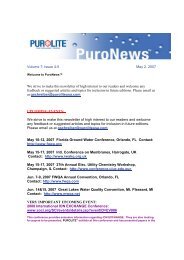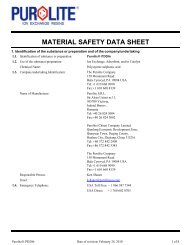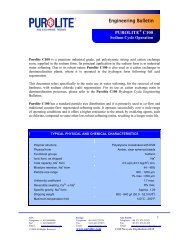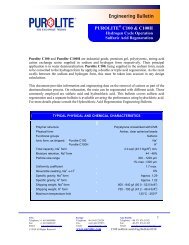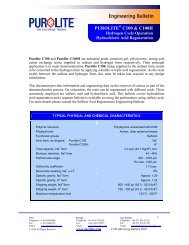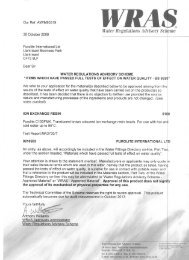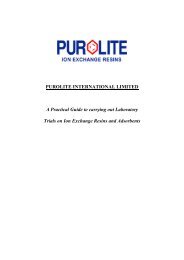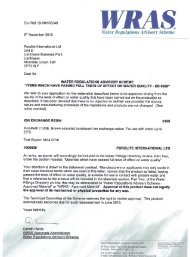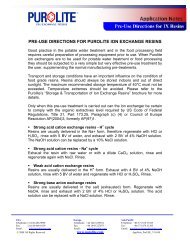Volume 1; Issue 6 June 16, 2001 Welcome to PuroNews ... - Purolite
Volume 1; Issue 6 June 16, 2001 Welcome to PuroNews ... - Purolite
Volume 1; Issue 6 June 16, 2001 Welcome to PuroNews ... - Purolite
You also want an ePaper? Increase the reach of your titles
YUMPU automatically turns print PDFs into web optimized ePapers that Google loves.
<strong>Volume</strong> 1; <strong>Issue</strong> 6 <strong>June</strong> <strong>16</strong>, <strong>2001</strong><br />
<strong>Welcome</strong> <strong>to</strong> <strong>PuroNews</strong><br />
We strive <strong>to</strong> make this newsletter of high interest <strong>to</strong> our readers and welcome any<br />
feedback or suggested articles and <strong>to</strong>pics for inclusion in future editions. Please email<br />
us at gschreiber@puroliteusa.com<br />
A NEWSLETTER FOR THE INDEPENDENT CULLIGAN DEALER<br />
UPCOMING EVENTS:<br />
The annual Great Lakes WQA Convention will be held <strong>June</strong> 28 - 29 at the Troy Marriott<br />
Hotel, Troy, Michigan. I will be manning our booth there and look forward <strong>to</strong> visiting with<br />
any who attend. Their Golf Outing will be at 10:00 a.m. on <strong>June</strong> 28 with registration at<br />
9:15 a.m. I'll be doing that also and will partake of the frustrations of knocking the little<br />
white ball around the course much unlike Tiger Woods.<br />
RESIN DEFOULING - DI APPLICATIONS: Many times we receive calls requesting<br />
help with DI resin problems. More often than not the problems are diagnosed as "Fouled<br />
Anion Resin". Prevention of Anion Resin Fouling is obviously the best way <strong>to</strong> of<br />
handling defouling. Sometimes, in spite of your best efforts, fouling will occur. Hardness<br />
fouling of Anion resin will occur if a Deionizer is overrun by the user. This exhausts the<br />
Cation resin and means that the Anion resin will see hard water. Hardness fouling will<br />
also occur in a Mixed Bed Deionizer if the feed water is not presoftened. With Mixed<br />
Beds on hard water you can just assume the Anion resin is hardness fouled and treat<br />
accordingly. Organic fouling is most applicable <strong>to</strong> Anion resin. It is very difficult <strong>to</strong><br />
organically foul a Cation resin. Other foulants such as oil, bacteria or algae or metals<br />
like iron, copper, zinc, etc. can foul a Cation resin in a DI application. Resin fouling can<br />
occur if the feed water analysis changes, operating conditions change, incorrect<br />
regeneration procedures, mechanical malfunctions, or failing <strong>to</strong> operate the system<br />
properly. We'll discuss fouling by resin category.<br />
CATION: OIL FOULING - Oils can coat the resin beads and prevent ion exchange. Oil<br />
fouling can be identified by a "rainbow" effect on the water or by testing a sample of the<br />
water with flakes from a Camphor Stick. The Camphor Stick can be purchased at Drug<br />
S<strong>to</strong>res. It comes in a small square block. Scraping off some flakes in<strong>to</strong> a saucer of the<br />
water from the DI tank and watching the action of the flakes will indicate possible oil<br />
fouling. If the flakes spin in the water there is likely no oil present. If they lay there like<br />
"dead ducks" then the water likely contains oil. Unless the resin is "heavily oil fouled"
you should be able <strong>to</strong> defoul it using a nonionic surfactant. First backwash and then<br />
drain the unit. Fill it with a solution containing 0.1% of the surfactant. Soaking the resin<br />
in that solution and if possible injecting compressed air for agitation for half an hour and<br />
then thoroughly backwashing the unit and rinsing downflow until all foaming disappears<br />
completely should defoul the resin. The resin should then be regenerated using normal<br />
regeneration procedures. Some have found success using DAWN DISH DETERGENT<br />
as the surfactant. Others have purchased a product call TRITON X100 from various<br />
chemical suppliers. You can contact me for more information on that product.<br />
BACTERIA or ALGAE FOULING - Peracetic Acid would be my first choice in<br />
disinfecting resin contaminated with Bacteria or Algae. It is a derivative of Hydrogen<br />
Peroxide. Using a Peracetic Acid solution of 0.2% for one hour followed by thorough<br />
rinsing for about 45 minutes should do the job. Make up 1 Bed <strong>Volume</strong> (BV) of a<br />
solution containing 0.2% Peracetic Acid. A BV is the equivalent of 7.5 gallons of solution<br />
for each cubic foot of resin <strong>to</strong> be treated. Inject this at a flow rate of 5 BV/hr with<br />
displacement <strong>to</strong> drain. When all has been injected, s<strong>to</strong>p the procedure and allow the<br />
resin <strong>to</strong> soak for one hour. Continue the displacement rinse for at least 60 minutes at 5<br />
BV/hr followed by a fast rinse for 30 minutes. The resin should then be regenerated<br />
using normal regeneration procedures.<br />
Formaldehyde is another alternative. I am not fond of this since it can be hazardous <strong>to</strong><br />
deal with. Make up 3 BV of solution containing 0.5% Formaldehyde. Commercial<br />
Formaldehyde (called Formalin) contains 40% Formaldehyde and should therefore be<br />
diluted approximately 80 times. Inject 1 BV of the solution at a flow rate of 5 BV/hr<br />
discharging <strong>to</strong> drain. If possible, drain down the unit <strong>to</strong> a level about 2 inches above the<br />
resin surface. Inject a second BV and retain that in the resin for a period of at least 8<br />
hours or preferably overnight. Flush the unit until no Formalhdehyde is detectable by<br />
Schiffs Test. Regenerate the resin TWICE.<br />
Sodium Hypochlorite is an alternative that can also be used. A 1% chlorine solution<br />
should be used. The resin should be in the thoroughly exhausted form. This will prevent<br />
production of chlorine gas. Make up 3 BV's of solution. The first bed volume should be<br />
passed through the bed at the normal regeneration flow rate or about 4 BV/hr. The<br />
second BV should be retained in the bed for no more than 2 hours. The third BV should<br />
be passed through the bed at the same flow rate as the first. This should be followed by<br />
a displacement rinse at about 4 BV/hr with softened water and then rinsed thoroughly <strong>to</strong><br />
drain. At least 8-10 BV's will be required. Test <strong>to</strong> insure all chlorine is removed. The<br />
resin should then be TRIPLE regenerated. CAUTION: Suitable safety precautions<br />
should be taken when using Sodium Hypochlorite and drains in<strong>to</strong> which the<br />
waste is <strong>to</strong> be discharged should be free from acids or other chemicals which<br />
may react adversely with the discharge.<br />
METALS FOULING - Normal regeneration procedure of Cation by HCl should remove<br />
any metals fouling. However, a double dose regeneration is preferable if the metals<br />
fouling is suspected.
ANION: HARDNESS FOULING: This will occur on any Anion resin exposed <strong>to</strong> hard<br />
water. It can be seen in the backwashing by a white cloudy appearance <strong>to</strong> the<br />
backwash water or tested for by testing a sample of the water for Hardness in the Anion<br />
vessel. Hardness fouling can be removed by regenerating the Anion resin on the Cation<br />
PE Regeneration station. CAUTION: The Anion resin must be <strong>to</strong>tally exhausted<br />
before the defouling with acid procedure is done. After the defouling procedure is<br />
done the resin must have all acid <strong>to</strong>tally rinsed out before the resin is then<br />
regenerated. After the Cation regeneration of the Anion resin is done the Anion resin<br />
should then be given a double dose Anion regeneration. Any anion resin that is part of a<br />
Mixed Bed DI resin bed should be assumed <strong>to</strong> be Hardness fouled if the feed water is<br />
not softened.<br />
ORGANIC FOULING: This will typically occur with any Anion resin used on waters with<br />
more than 1 ppm TOC. It can be seen in a dark brown color <strong>to</strong> the regenerant waste<br />
water and sometimes even in a yellow <strong>to</strong> brown color in the backwash water. In<br />
addition, Organic Fouling can be detected in symp<strong>to</strong>ms of poor capacity, long rinse time<br />
and high Silica leakage. There is a very large spectrum of Organics that can foul an<br />
Anion resin. Proper pretreatment of the feed water <strong>to</strong> the Deionizer when the TOC<br />
exceeds 1 ppm is the best prevention of Organic Fouling. This can be accomplished in<br />
some cases with Activated Carbon as the pretreatment or by pretreating with an Anionic<br />
Organic Scavenging Ion Exchange Resin.<br />
The resin should be treated at the end of a normal exhaustion cycle. This is called a<br />
Warm Brine Squeeze. 3 BV's of 10% brine containing 2% Caustic Soda should be<br />
prepared. This solution should be a minimum of 95 degrees F. For a Type 1 Anion resin<br />
the temperature can be as high as 140 degrees F. One BV should be introduced at a<br />
flow rate of 2 BV's/hr followed by a second BV - this second BV should be retained in<br />
the resin bed for at least 2 hours (longer if possible). Some agitation should be<br />
employed periodically throughout that time. At the end of the retention time the 3d BV<br />
should be passed through the bed at 1 BV/hr and then the resin thoroughly rinsed with<br />
Decationized or Soft Water. The resin should then be regenerated by 2 complete<br />
regeneration cycles.<br />
IRON FOULING: Sometimes Organics have Iron bound in<strong>to</strong> them which will cause Iron<br />
Fouling of the Anion resin. If this is suspected then, prior <strong>to</strong> the Warm Brine Squeeze,<br />
do a Hardness Defouling procedure as stated above. If Organic fouling is still expected,<br />
then the Warm Brine Squeeze can be done.<br />
NOTE: At the <strong>Purolite</strong> USA web site www.puroliteusa.com you can go <strong>to</strong> our<br />
"LIBRARY" page on that site and download our bulletins "Fouling of IEX and<br />
Cleaning" and "Organic Fouling of Anion Resins" for more information. Also on<br />
that web site is a "BULLETIN BOARD" page. You can post any questions there<br />
and we will reply. It is an interesting page with all of the questions and replies<br />
permanently maintained.<br />
Remember, Mixed Bed DI resins are just a mix of Cation and Anion resins. Separate<br />
treatment for fouling is required. Also, remember that proper pretreatment and proper<br />
operation of the Deionizer are critical <strong>to</strong> preventing resin fouling. Finally, without a
COMPLETE analysis of the water <strong>to</strong> be treated one cannot accurately predict capacity<br />
and fouling potentials.<br />
This ends this issue of <strong>PuroNews</strong>. If you know of anyone who does not receive<br />
this but should, please either send me their email address or tell them <strong>to</strong> send me an<br />
email or FAX or call me <strong>to</strong> request it. Thank you <strong>to</strong> those of you who have done that.<br />
If you would like any back issues of <strong>PuroNews</strong> just go <strong>to</strong><br />
www.purolite.com Go <strong>to</strong> the "LIBRARY" link in the drop down list and click on it.<br />
Then scroll down <strong>to</strong> "PURONEWS". Click on it. Then click on the issue you want.<br />
You can then download and print each.<br />
If you no longer wish <strong>to</strong> receive <strong>PuroNews</strong>, click on my email<br />
address gschreiber@puroliteusa.comand type REMOVE in the subject line.<br />
GARY SCHREIBER, CWS VI<br />
The <strong>Purolite</strong> Company<br />
CONTACT INFO:<br />
Schreiber Phone: 1-800-834-8784 or 1-507-448-3560<br />
Schreiber FAX: 1-507-448-3508<br />
Schreiber CELL: 1-507-271-6866<br />
<strong>Purolite</strong> USA Phone: 1-800-343-1500 or 1-610-668-9090<br />
<strong>Purolite</strong> USA Email: gschreiber@puroliteusa.com<br />
<strong>Purolite</strong> Global Web Site: www.purolite.com .<br />
Visit these sites <strong>to</strong> get more answers <strong>to</strong> your resin application questions.<br />
<strong>Purolite</strong> International Email: info.uk@purolite.com<br />
<strong>Purolite</strong> International Phone: +44 1443 229334<br />
Just Ask <strong>Purolite</strong>.





